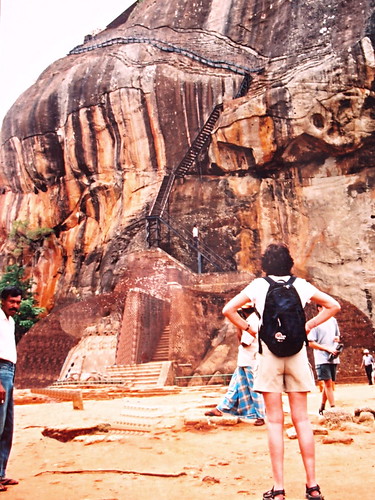“What are those tiny ledges cut into the face of the rock for?” I asked my guide.
“That is where the guards stood, Madam, and if the guard fell asleep, the rock would exact punishment.”
“What do you mean?”
“The guard simply fell to his death, Madam.”
They may be great stories with which to regale the tourists, but to a vertigo sufferer who was about to ascend the 200 metre sheer face of Sigiriya, it was like dowsing a fire with petrol.
I first discovered I had vertigo when I stepped out of the elevator on the top floor of the Sears Tower in Chicago. As I walked towards the glass side of the building my knees buckled and sheer, unadulterated fear grasped me by the throat. Since then my vertigo hadn’t really impacted much on my travels, so I didn’t give it a second thought when I decided on a visit to the ancient rock fortress of Sigiriya.
It was a cloudy day but sweat was running down my back by the time we reached the caged spiral staircase which snakes up to the ledge containing the famous Sigiriya Damsels.
Climbing the staircase I suddenly became aware of being suspended in open space high above the jungle and the first signs that Sigiriya may be more of a challenge than I realised entered my thoughts. I reached the gallery carved into the red rock and was bewitched by the beauty of the frescoes which glowed golden in the afternoon light. But enchantment dissipated instantly as I climbed back into that open spiral staircase and the jungle floor started spinning. When my feet trembled onto the ground, I headed to the Mirror Wall to recover and hoped I’d done the worst of it.
We arrived at Lion’s Platform; a large rock terrace at one side of which a few vendors were selling drinks and souvenirs. My heart sank as I caught sight of the next and final stage of the climb. A sheer, 150 metre high cliff loomed, silhouetted against the sky like a shadow on a lung X-ray. On its surface I could just make out the thin handrail that snaked like a cotton thread along the scars in the rock face. My legs were still weak from the climb to the frescoes. I was pretty sure I couldn’t do it and would have to wait on Lion’s Platform for a return guide.
Then I heard a loud buzzing behind me and turned to see a girl flailing wildly at a wasp the size of a small bi-plane.
“No, no, please do not annoy the wasps! They will sting and many more will come!” said my guide, pointing to an overhang in the rock above us from which three or four large black cones hung, their living surfaces rippling. A wisp of smoke plumed away from one of the cones as a squadron of stingers headed towards us. I was gob smacked and facing a literal ‘between a rock and a hard place’ dilemma – vertigo or angry, giant wasps.
I watched a group of young saffron-robed monks heading through the stone lion’s feet and taking the steps two at a time, passing sari-clad women in their threadbare sandals, some of whom must have been in their seventies. I clenched my jaw, I would not be defeated by this rock. I refused to fail to do what a group of kids and elderly women were doing without a second thought.
The higher we climbed, the narrower the steps became and the single, rickety bar of rusty metal which stood between me and certain death got steadily lower and thinner. I was doing okay until we had to wait for a long line of people descending the rock to pass us. I raised my eyes to the horizon and the fear that had been lodged like a stone in my throat rose to my brain. I started to panic and hysteria threatened to engulf me.
The fear must have shown on my face because I was vaguely aware of people asking me if I was okay. Then a stranger who was passing us in his descent spoke to me:
“You’ve done the worst,” he said, “you’re at the top now.”
It took a couple of seconds for the words to register in my spinning brain but when they did, it was just what I needed to hear; if I’d done the worst, I could do the rest.
I forced my feet to move and kept my eyes steadfastly on the back of the guide directly in front of me as I continued the ascent on boneless legs. Finally making it to the top, ranks amongst the top ten in my buzz trips experiences.
There were the young monks I had seen earlier, surreptitiously listening to pop tunes on a transistor radio concealed within the robes of one of their number, and the old women confidently shuffling around the ancient rock as if it were their village.
I was elated. Not for the first time, Sri Lanka had challenged me to raise my game to reap her rewards and this time, I’d met the challenge head on.
Andrea (Andy) Montgomery is a freelance travel writer and co-owner of Buzz Trips and The Real Tenerife series of travel websites. Published in The Telegraph, The Independent, Wexas Traveller, Thomas Cook Travel Magazine, EasyJet Traveller Magazine, you can read her latest content on Google+





Be the first to comment